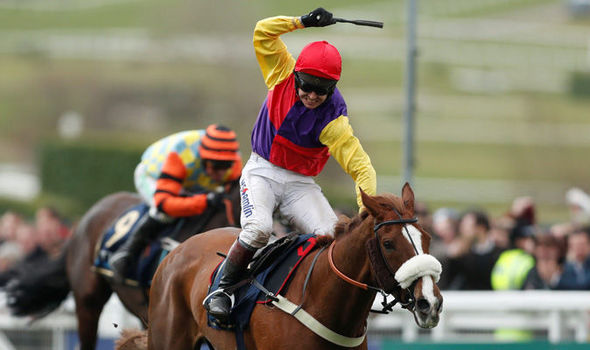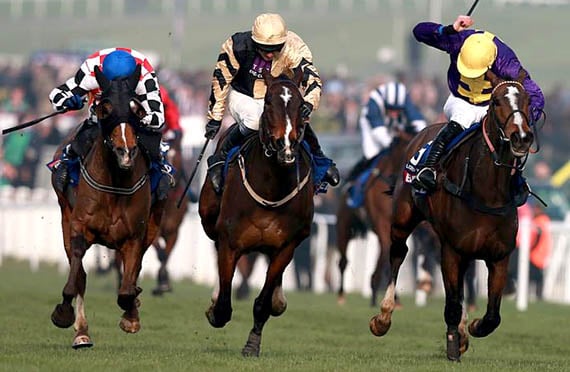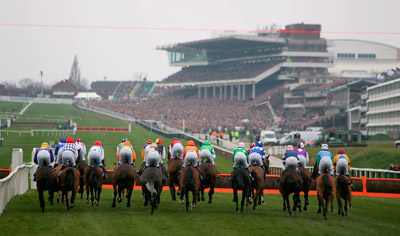The British Horseracing Authority asking jockeys to adjust their riding style a month before Cheltenham is like asking a golfer to change their swing just before The Masters, says former multiple Grade 1-winning jockey Sam Thomas.
The bedding-in period for the new whip rules began on January 9 and the rules will come into force today, Monday February 13.

The Racing Post reports that with the Cheltenham Festival beginning on March 14, it gives riders just a month to adapt to the new rules and trainer Thomas, who rode the likes of Kauto Star and Denman to Grade 1 success, is sceptical about their introduction so close to the festival.
“I’d say the shoulder height rule will take a very long time for riders to adapt to,” he said. “Everyone can count generally, that’s the easy part, changing your actual style is going to be very tricky. You see golfers try to change their golf swings and completely lose their form for a long while – it’s not something that can be easily done.

“Everything needs a bedding-in period, the start of the season would have made sense or the start of the summer, that would have been a better time when people were having less rides. It would have given them more time to adapt their styles and get used to it.”
Representatives from the BHA were at last weekend’s Dublin Racing Festival to discuss the new whip rules with Irish-based jockeys, for whom the Cheltenham Festival will likely be their first encounter with the changed rules.
Thomas believes their introduction so close to the marquee event will lead to jockeys being unnecessarily distracted during races, and he expects there to be “plenty of bans”.
“I think it’s going to be a real challenge for riders,” he added. “It’s another thing you don’t want to be thinking about when you’re riding. You have enough things to think about when you’re taking part in a race and it’s another thing that could take their mind off what they should actually be thinking about.
“It’s not going to be easy for them and I would imagine there will be plenty of bans. The jockeys are going to have to be very careful.”
The new rules have drawn criticism from many senior jockeys including Sean Quinlan, who revealed he would have been suspended for 51 days after riding a winner at Sedgefield in January.
Harry Cobden labelled the rules “bloody ridiculous” when speaking to the Racing Post in December, while champion jockey Harry Skelton and Nicky Henderson’s stable jockey Nico de Boinville have also expressed concern over the timing of their implementation.
The BHA said in a media statement last week that throughout the bedding-in period they have worked with the PJA and jockeys to identify where improvements could be made to the raceday procedures and the Whip Review Committee process.
This was the purpose of the bedding-in period.
Over the course of this period they have refined the way the Stewards and the Whip Review Committee are assessing rides as part of their operating procedures, to ensure the rules and guidance are being applied proportionately, as intended and within the scope of the guidance.
This includes, for example, refined procedures for Stewards and the Whip Review Committee to assist with identifying use of the whip above shoulder height in a proportionate manner.

In addition, they have marginally adjusted the way penalties are calculated to ensure they will also be applied proportionately. This includes ensuring that only offences for use of the whip above the permitted level are being doubled in Class 1 and 2 races (noting that the vast majority of all pre-reform whip offences were for above permitted level), and a tweak to how offences are aggregated where multiple offences are committed in the same ride.
A BHA spokesperson said:
“The rules being implemented on Monday are the result of a detailed consultation process designed to foster more considered and judicious use of the whip.
“They are being introduced after an extensive bedding-in period which has successfully allowed jockeys and officials to familiarise themselves with the new rules and guidance and identify where improvements can be made to their implementation, or where some jockeys might need to adapt their riding style. This was the purpose of the bedding-in period.

“We are grateful for the input of the PJA, NTF and a number of senior riders and trainers and we have now reached a position where the new rules and guidance will be implemented in the manner in which they were intended.
“We were pleased to note jockeys stating that the responsibility now rests on them to ride within the new rules and adapt their riding style where necessary. We have already seen this happening during the bedding-in period, for which jockeys deserve great credit.”
The BHA also noted:
- The main change for riders is the reduction in thresholds for use. For most jockeys this does not involve a substantial change in riding style. Those who have required to change have been given over two months to do so.
- It is not “new” that jockeys can be found in breach of the rules for using the whip above shoulder height. This has been a part of Britain’s – and other racing nations’ – whip rules for many years, alongside other elements such as when out of contention, without time to respond, when clearly winning etc.
The new rules:
The basic rules for use within a race, implemented as of 13 February in Jump racing and 27 March in Flat racing, are as follows:
- The whip can be used a maximum of six times in a Flat race or seven times in a Jump race. Any more than this will prompt the stewards to review the ride.
- As well as the number of times the whip is used, The Whip Review Committee will look at the force with which it is used, whether it was used from above shoulder height, whether the horse has been given time to respond, the purpose for which the whip was used, whether the horse was in contention or clearly winning at the time it was used, and whether the whip has been used in the correct place (i.e. on the horse’s hindquarter rather than flanks).
- Any rider found to have contravened the rules or guidance will face a period of suspension, and any rider picking up third suspension in a six-month period will be referred to the Judicial Panel for penalty.
- Should the whip be used four times or more above the permitted level, the horse and rider will be disqualified from the race.








